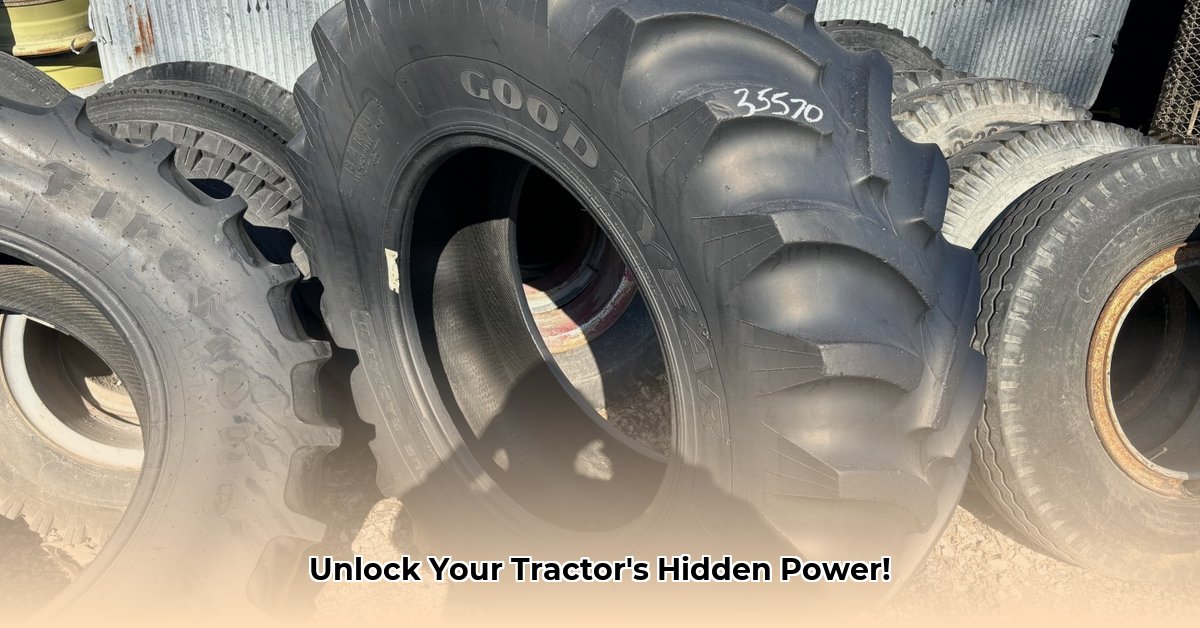
Understanding 18.4 x 30 Tractor Tires: A Deep Dive
Choosing the right tractor tires is paramount for efficient and productive farming. The 18.4 x 30 size is a common choice, but selecting the optimal tire involves careful consideration of several key factors. This guide will equip you with the knowledge to make an informed decision and maximize your tire's performance and longevity. Don't underestimate the impact of your tires; they directly influence fuel efficiency, traction, and overall operational lifespan. A well-informed choice translates to significant cost savings and increased productivity. For more options, check out our guide on 16-inch rim tires.
Technical Specifications and Comparison: Decoding the Data
The dimensions "18.4 x 30" refer to the tire's width and diameter. However, several other specifications significantly impact performance. Understanding these allows for a more informed comparison across brands. Unfortunately, complete, directly comparable data across all brands is scarce. Manufacturers often present information differently, hindering easy side-by-side analysis.
Key Specifications and Their Influence
Load Capacity (kg): This indicates the maximum weight a tire can safely support. Higher capacity is beneficial for heavier implements but increases ground pressure, potentially impacting soil compaction.
Ply Rating: Represents the number of rubber and fabric layers in the tire. A higher ply rating denotes greater strength and durability, ideal for rough terrain and heavy loads. However, this often comes at the cost of slightly reduced fuel efficiency and a firmer ride.
Tread Pattern: The design of the tire's outer surface dramatically affects traction and self-cleaning. Deep lug patterns excel in mud and loose soil, while shallower designs offer better performance on hard surfaces. Choose a pattern matching your primary soil conditions and farming practices.
Construction (Radial vs. Bias): Radial tires generally provide better fuel efficiency and ride comfort, while bias-ply tires tend to be more robust and less expensive initially.
Tread Depth: Greater depth translates to longer wear life and improved traction, particularly in challenging conditions. However, deeper treads may compromise slightly on fuel efficiency on hard surfaces.
Challenges in Direct Comparisons: The lack of standardized data presentation across various manufacturers makes direct comparisons challenging. It's essential to consult individual manufacturer specifications and acknowledge the limitations in comprehensive cross-brand comparisons.
Performance Analysis: Traction, Fuel Efficiency, and Longevity
The interplay between tire specifications and actual performance is complex. While a direct numerical comparison across brands is difficult due to data limitations, understanding the influence of each specification is crucial.
Traction: Aggressive tread patterns with deep lugs provide superior traction in challenging soil conditions (muddy, loose). However, shallower patterns are more fuel-efficient on hard surfaces.
Fuel Efficiency: Radial tires generally enhance fuel efficiency compared to bias-ply tires. Lower rolling resistance translates to reduced fuel consumption.
Longevity: Higher ply ratings and deeper tread depths typically contribute to longer tire lifespan. However, higher ply often means a slightly firmer ride. Proper maintenance (discussed below) significantly extends the life of any tire.
Soil Compaction: Higher load capacity tires, while beneficial for heavier loads, can increase soil compaction. Consider this factor, especially in sensitive soil conditions.
Buying Guide: A Step-by-Step Approach
Choosing the right 18.4 x 30 tires involves a methodical approach. Here's a step-by-step guide:
Assess Your Needs: Determine your primary soil type, typical workloads, and budget.
Consult Your Tractor Manual: Verify the manufacturer's recommended tire sizes and load ratings.
Gather Specifications: Obtain detailed specifications from various tire manufacturers for their 18.4 x 30 offerings.
Create a Comparison Table: Organize the data in a table highlighting key differences (load capacity, ply rating, tread pattern, construction type, price).
Analyze and Compare: Identify tires that align best with your specific requirements, considering the trade-offs between various specifications.
Seek Expert Advice: If needed, consult with experienced agricultural professionals or tire specialists for tailored guidance.
Tire Maintenance: Maximizing Lifespan and Performance
Proper maintenance is crucial for maximizing tire life and performance.
Inflation: Maintain correct tire pressure as recommended by the tire manufacturer and consult your tractor's manual. Under-inflation leads to excessive wear and reduced fuel efficiency. Over-inflation weakens the tire structure.
Regular Inspection: Perform regular visual checks for cuts, embedded objects, or signs of unusual wear. Address minor issues promptly to prevent major problems.
Rotation (if applicable): Rotate tires periodically to ensure even wear.
Storage: If storing tires for extended periods, ensure proper storage minimizes degradation and damage.
Troubleshooting: Addressing Common Issues
Even with careful maintenance, tire problems can arise:
Punctures: Minor punctures may be repairable with a plug kit. Significant damage often requires professional repair or replacement. Consult the manufacturer's guidelines before attempting repairs.
Abnormal Wear: Uneven wear might indicate improper inflation, wheel alignment issues, or damage.
Bulges or Cuts: Inspect tires for these regularly and address them immediately.
Conclusion: Investing in Performance
Choosing the right 18.4 x 30 tractor tires is an investment in your farm's efficiency and profitability. The information provided is a guide; specific requirements vary depending on individual circumstances. Always consult with tire professionals or agricultural equipment dealers for personalized advice tailored to your specific needs and operating conditions. Remember to prioritize safety and comply with all manufacturer recommendations.